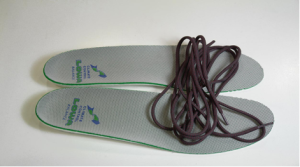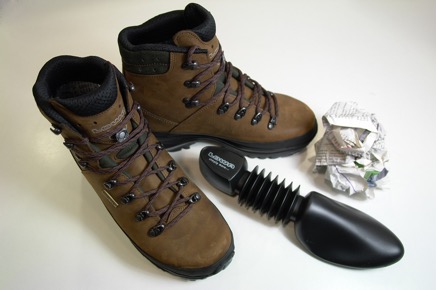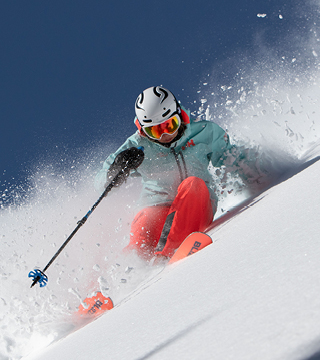Dirt and moisture have little effect on LOWA boots if they are properly looked after. The right kind of care can significantly lengthen the lifespan of your boots. Leather is a natural raw material which needs to be cared for. Real leather is like a second skin. In order to maintain leather‘s exceptional qualities, proper care is vital. The photograph below shows LOWA boots after hard use in open country. The boots are wet and the leather is covered in dirt.

1) First, remove the insole and laces:
The boots should be allowed to air properly and dry out after each and every use. It is good to remove the in-soles and laces to open them up fully and allow them to dry. The in-sole absorbs a lot of moisture, which will dissipate and dry much quicker outside of the boot. This is important to remember on multi-day trips. In an ideal world, leather boots should be dried out for 24 hours before they are worn again.

2) Removing dirt from leather boots:
Once the in-soles and laces have been removed, the dirt must be removed from the leather. For heavily soiled boots, a specialist shoe cleaning product that will also remove the toughest dirt is advised. For normal levels of dirt, brushing it off under lukewarm running water will suffice. When using cleaning products, make sure you impregnate them thoroughly afterwards (Cleaning products open the leather “pores” and impregnation closes them again).
Remove the dirt from the leather with lukewarm water:
Brush the boots thoroughly so that the leather can breathe again and its properties are revived. Lukewarm soap suds are usually a good substitute for specialist cleaning products and can also be used to clean the in-soles. You will see how the water is instantly absorbed by the leather. The leather is now in an unprotected state.

3) To protect the leather from water, it must be waterproofed:
The cleaned boots are still very “open-pored” and will soak up water even more due to the application of cleaning products. In order to “close” the leather again, an impregnating spray should first be used when they are still damp. We recommend our LOWA Water Stop which is sprayed on.
Impregnating the leather prevents water absorption. The leather still keeps its breathing properties. Smooth or waxed leathers are easier to care for than Nubuk or Suede and more resistant to water and dirt.

4) To maintain and protect your boots:
Once your boots have been water-proofed they should also regularly have a water-based cream rubbed or polished into them (with a brush), especially when they have had a soaking. We recommend our LOWA Active Cream which can be applied with a sponge. DO NOT use care products containing: beeswax, animal fats and petroleum oils e.g. Dubbin, Neatsfoot Oil, Mink Oil and Sno-Seal.

Water, together with dirt, washes away some of the leather’s properties. If these substances are not replaced in the form of a care-cream, the leather will dry out and eventually break up. The leather boot would then be irreparably damaged. Hard leather is also not flexible and pulls against the seams.
Using a hairdryer for some light heat will improve the absorption of the cream into the leather. Real leather only keeps its shape and stays flexible and hardy, when additional care products are used.

Testing the care procedure of real leather
If your boots are properly water-proofed and treated, water will form droplets as shown in the photograph below. This means that the leather is perfectly protected. If your boots are successful in this test, then you can congratulate yourself on looking after the leather properly. The right kind of care can significantly lengthen the life-span of your boots.

5) Give your boots ample time to dry:
Never place boots to dry on a radiator, too near to a fireplace or oven, inside a car or in the trunk of your car. They should also not be left on the back step in direct sunlight; the ambient temperature which develops can be as bad as a heater or open fire and the UV perishes the randing. Wet leather “burns” very easily (it becomes brittle and shrinks). This often results in irreparable rips in the leather where it creases when walking. Hooks and rivets also get pulled to bad effect.
6) The best place to store leather boots is in a shoe bag or box, in a dry, well-aired place. A wooden boot tree will help keep their shape. Never store wet boots in damp rooms or in the car. They will get mouldy! Wooden boot trees will help them keep their shape and prevent any creases in the leather.
If your boots are still damp, we recommend you stuff some newspaper into the toe box. The newspaper will absorb the moisture and also helps keep the shape. The newspaper should then be changed every day until the boots have dried out!

If you regularly care for your leather boots in this way, then they should give you many years of joy.

















